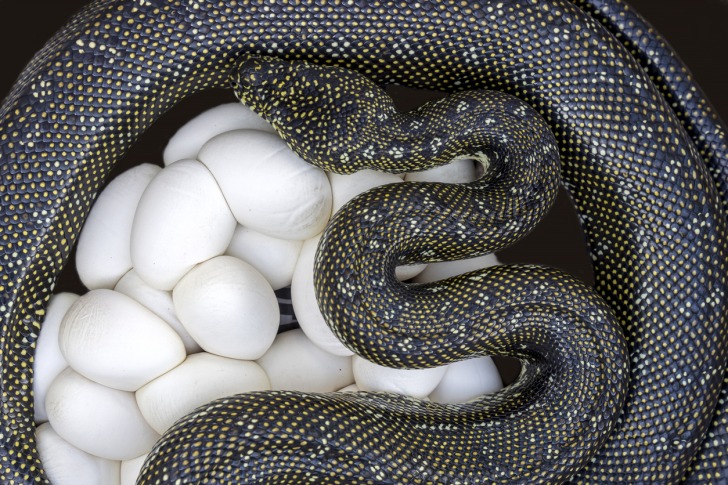Folklore depicts snakes as being fearsome, even evil creatures.
The Bible’s Book of Genesis depicts Satan as a snake as he tempts Adam and Eve to disobey God by eating the fruit of the Tree of Knowledge of Good and Evil.
St. Patrick proves his holiness by driving all of the snakes out of Ireland.
The Medusa of Greek mythology had snakes instead of hair on her head.
Humans tend to fear snakes as deadly predators.
Some can be deadly, but some aren’t.
Even the deadly ones can be managed with a little knowledge and common sense.

Contents
So…Are There Snakes in Texas?
The short answer is yes, there are snakes in Texas.
Approximately 94 different types of snakes reside in the Lone Star State, but only a few are considered venomous.
Texas, being a large state, has a variety of habitats ranging from deserts to coastal waters that are ideal for several snake species.
However, anyone wanting to enjoy the great outdoors in Texas only has to worry about a few types of deadly snakes.
Snake Species in Texas
While most snakes are nonvenomous and harmless, those you have to worry about are divided into four main categories.
Rattlesnakes come in a variety of subspecies in Texas.
They include the western diamondback, the Timber rattlesnake, the Mottled rock rattlesnake, the Banded rock rattlesnake, the Blacktail rattlesnake, the Mojave rattlesnake, the Prairie rattlesnake, the Western massasauga, and the Desert massasauga.
Rattlesnakes are so called because of the rattling sound they make with their tails that deters predators such as hawks and weasels.
Most snake bites in the United States are caused by rattlesnakes, though they rarely attack unless provoked and their bites are rarely fatal if treated quickly.
Copperheads come in three subspecies in Texas, including the Southern copperhead, the Broadbanded copperhead, and the Trans-Pecos copperhead.
These snakes are so named because of the distinctive colors of their heads.
Copperheads have heat sensors on the sides of their heads that allow them to detect potential prey.
They are very likely to bite if cornered, but because they have short fangs and weak venom, copperhead bites are rarely fatal.
Cottonmouths are also known as water moccasins because they tend to prefer wet, swampy habitats.
They can be found on land if they are migrating between wet areas.
The name Cottonmouth comes from the white coloring on the inside of their mouths when they display their fangs.
While they are venomous, they rarely bite humans unless they feel threatened.
Coral snakes are so called because of their color, with red, yellow, and black covering their bodies.
Hence, they are easy to spot when moving on the ground.
They are small, shy creatures who can, nevertheless, inflict a serious bite if provoked.
Coral snakes are related to Indian cobras.
They tend to snack on small reptiles and other snakes,
Is it Safe to Go on a Trek in Texas?
Going out to explore nature in Texas is perfectly safe so long as you follow some sensible precautions.
Be mindful of your physical limitations.
If you’ve lived a sedentary lifestyle, a short hike over even ground might be better than a day-long trip in rocky terrain.
You should dress properly according to the season.
During the summer, which tends to be very hot in Texas, wear loose, light clothing.
Add to that sturdy hiking shoes or boots, a wide-brimmed hat, sunscreen, and insect repellent.
You should take plenty of water, about a quart for every hour on the trail.
Also, make sure you have a first aid kit and some food.
Check the weather report.
Be prepared for sudden rain as the weather can change quickly in Texas.
Carry a cell phone and a GPS device with a full battery, though you should be aware that reception is somewhat spotty in the wilderness.
Keep to the trail.
You are less likely to get lost and encounter unfriendly animals, including snakes if you leave the trail.
If you are concerned about getting a snake bite, consider investing in a pair of snake boots.
While they do not provide 100 percent protection against snake bites, they can usually ward off an attacking snake.
Some boots are of better quality than others, so do shop around.

Interesting Snake Facts in Texas
Snakes can be found throughout Texas.
There are no counties in Texas where snakes of one sort or another are not present.
7,000 people suffer snake bites every year in the United States of which 14 die as a result.
Approximately 1 or 2 people die of snake bites in Texas annually.
While many people keep snakes as pets, a man in Grand Prairie, Texas got into trouble when his pet cobra, a dangerous, venomous snake, escaped from his home and was never seen again.
He was eventually sentenced for violating the “release from captivity” code of the Texas Parks and Wildlife Department.
His sentence was 15 months of supervision, a small fine, and a prohibition from ever owning a snake or reptile again.
3 Safety Tips for Exploring Nature in Texas
When going out on a nature adventure, whether hiking, hunting, or camping, never go out alone.
If someone in a group becomes injured for any reason, the others can render aid.
Always tell someone where you’re going to be if you are venturing out to explore nature, including an estimated time when you’ll be back.
If you encounter a snake, stop and slowly back away.
Snakes only become aggressive if they feel threatened.
Summary
Snakes certainly make their home in all parts of Texas.
Only a few of the species can be considered dangerous.
However, by following some sensible precautions, anyone going out on a nature adventure can keep themselves safe from harm from the slithering creatures.
Texas Safety Overview
READ THE FULL REPORT: Texas Safety Review
Safety Index:
- OVERALL RISK: MEDIUM
- TRANSPORT & TAXIS RISK: LOW
- PICKPOCKETS RISK: LOW
- NATURAL DISASTERS RISK: MEDIUM
- MUGGING RISK: MEDIUM
- TERRORISM RISK: LOW
- SCAMS RISK: LOW
- WOMEN TRAVELERS RISK: LOW
Frequently Asked Questions
What do you do if you are bitten by a snake?
Forget the myth of cutting the area around the bite and sucking out the venom,
Instead, lie down so that your heart is level with the bite.
Have your friends transport you to the nearest emergency room as quickly as possible.
Call ahead and explain that a person with a snake bite is on their way so that an anti-venin can be prepared in advance.
Which cultures worshiped snakes?
While Western cultures regard snakes as figures of evil, that belief is not universal.
Some Mesoamerican people worshipped snakes as gods.
The Aztecs, for instance, venerated Quetzalcoatl, a feathered serpent who brought rain and fertile crops when properly worshipped.
Some fringe Christian churches use snake handling as part of their worship service.
The idea is that the power of God will protect the believer from the harm a snake might inflict upon him.
Do some people eat snakes as food?
Some cultures, especially in the Far East, regard snake meat as a delicacy.
Indeed, a Hong Kong Pizza Hut uses a snake as a pizza topping,
In the West, snake meat is an acquired taste for many.
The joke is that it tastes like chicken, but is said to have an earthy, gamey taste when cooked.











